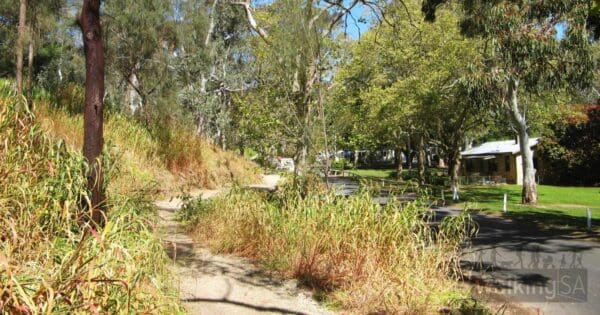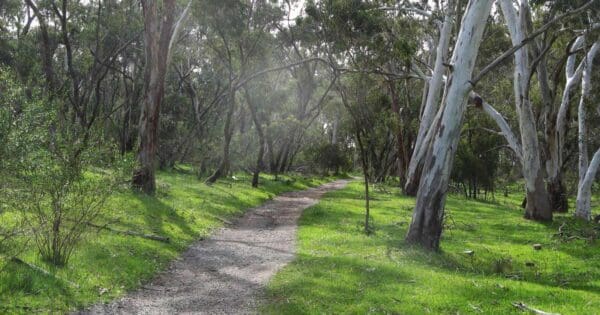Hike at a Glance
Max elevation: 176m
Min elevation: 110m
Total Ascent: 147m
Hike overview
The Wirraparinga Trail Loop offers a scenic 5.5-kilometer (grade 3) hike through Brownhill Creek Recreation Park in South Australia. This moderately challenging circuit, taking roughly 2.5 hours to complete, follows the Brownhill Creek Valley, showcasing majestic river red gums, some exceeding 300 years old.
The trail consists of two segments: the Wirraparinga Trail traverses the valley's southern side, while the Shared Use Trail follows the creek on the northern side. Hikers can easily combine these paths into a loop, starting near the caravan park and turning back at the Manure Pits.
One highlight of the hike is the "Monarch of the Glen," a monumental 400-year-old river red gum. Its cavernous trunk served as a shelter for Kaurna Aboriginal people and even European colonists as late as the 1950s, with historical accounts mentioning births occurring within the tree.
Brownhill Creek Recreation Park is dog-friendly, but leash laws require canines to be under control at all times. The Shared Use Trail, specifically designed for accessibility, is suitable for bicycles, prams, and wheelchairs. This trail begins near the caravan park, initially located on the road's north side until reaching Whites Bridge, where it switches to the south side.
Track grade
Grade 3 (Moderate) - Walks for Most Fitness Levels: Grade 3 on the AWTGS represents moderate walking tracks. These are ideal for walkers with some fitness who are comfortable with some hills and uneven terrain. While suitable for most ages, some bushwalking experience is recommended to ensure a safe and enjoyable experience. Tracks may have short, steep hill sections, a rough surface, and many steps. The total distance of a Grade 3 walk can be up to 20 kilometers.
Walk map and GPX file
Max elevation: 176 m
Min elevation: 110 m
Total climbing: 147 m
Total descent: -146 m
Content use
Please don’t copy GPX files or content from this site to AllTrails or other platforms. Each trail has been personally mapped, documented, and refined to support Australia’s bushwalking and hiking community. While some details come from land managers, every listing reflects significant personal effort. This is a free, community-driven initiative—your respect helps keep it that way.
Gallery
Got any photos from this hike? Your photos can help others plan. Share shots from along the trail so fellow hikers know what to expect.
Click to add your photos >>
Getting there
Getting to the trailhead: Brownhill Creek Recreation Park.
Reaching Brownhill Creek Recreation Park is convenient for visitors by car or foot. Situated just 8 kilometers from Adelaide, the park is easily accessible. If you’re driving, follow Brownhill Creek Road until you reach the park entrance. Alternatively, for those seeking a more active approach, Northbrook Avenue offers a pedestrian and cyclist-friendly access point.
Need a rental car to get you to the hike? Find one here.
Find a place to stay
Wondering where to stay near this hike? Find accommodation close to the trailhead — hotels, cabins and campgrounds nearby. Click the button to view the interactive map.
Closest towns to this walk: Adelaide, Aldgate, Brownhill Creek, Crafers, Glen Osmond, Goodwood, Mitcham, Stirling, Unley, Upper Sturt
Let someone know
Heading out? Fill in a trip intentions form so someone knows your plans. If things go wrong, they can raise the alarm fast, giving you peace of mind on the trail.
About the region
Nestled just 8 kilometers from Adelaide's city center, Brownhill Creek Recreation Park offers a welcome escape into nature. Encompassing 51 hectares, this scenic park provides a variety of recreational activities for visitors. Hike or bike along the trails, explore the park on horseback using the designated trail and fenced exercise area, or simply enjoy a picnic surrounded by the beauty of the natural environment.
Brownhill Creek, the park's namesake, winds its way through a steep valley adorned with majestic river red gums, some standing tall for over 300 years. Evidence suggests this area held significance for the Kaurna Aboriginal people, serving as a favored location for camping, hunting, and gathering.
The park boasts a diverse range of flora. Towering river red gums flank the creek, while blue gum woodlands carpet the valley slopes. Additionally, a small but threatened ecosystem of greybox grassy woodland finds refuge within the park's boundaries.
The natural beauty of Brownhill Creek Recreation Park extends beyond the flora. The creek valley serves as a vital wildlife corridor for over 40 species of birds and mammals. Kookaburras, bats, possums, water rats, frogs, and even the occasional koala call this park home. Notably, the park provides habitat for the nationally endangered southern brown bandicoot.
Similar walks nearby
Looking for more walks in or near Brownhill Creek Recreation Park? Try these trails with a similar difficulty grade.
Explore safe
Plan ahead and hike safely! Carry enough water, pack layers for changing conditions, and bring safety gear like a torch, PLB, and reliable communication device. Check official sources for trail updates, closures, and access requirements, and review local weather and bushfire advice. Most importantly, share your plans with someone before you go. Being prepared makes for a safer and more enjoyable hike! Stay Safe, Explore More, and Always #ExploreSafe.
Packing checklists
What you carry in your pack depends on factors like weather, terrain, and your adventure type. Not sure what to bring? My free planning, food, and packing checklists are a great starting point, covering day hikes, overnight trips, and multi-day adventures. Use them to customise your kit and always prioritise safety.
Suggest an edit
Notice something different about this trail? Whether it’s a new feature, a route change, or a closure, share your update so we can keep our info accurate and helpful for fellow hikers.
Click to suggest edits >>
Acknowledgement of Country
Trail Hiking Australia acknowledges the Traditional Owners of the lands on which we hike and pay respects to their Elders, past and present, and we acknowledge the First Nations people of other communities who may be here today.






